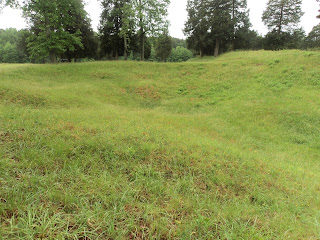Hike Location: Three Lakes Park and Nature Center
Geographic Location: north of Richmond, VA (37.61817, -77.43009)
Length: 1.5 miles
Difficulty: 1/10 (Easy)
Date Hiked: May 2018
Overview: Three flat circumnavigations of three lakes.
Park Information: https://henrico.us/rec/places/three-lakes/
Directions to the trailhead: On the north side of
Richmond, take US 301 to Wilkinson Road.
This intersection is located 1.5 miles north of I-95 exit 82 or 1.5 miles
south of I-295 exit 38A. Go east on
Wilkinson Rd. Drive Wilkinson Rd. 0.9
miles to the signed park entrance at Sausiluta Drive on the right. Turn right to enter the park, and park in the
large paved parking lot in front of the Nature Center.
The hike: Owned
and operated by Henrico County, tiny Three Lakes Park and Nature Center
consists of 118 acres in densely populated suburban Richmond. As its name suggests, the park features three
lakes, unimaginatively named Lake 1, Lake 2, and Lake 3 in increasing order
from east to west. The park also has a
play area and two picnic shelters, but perhaps the park’s best amenity is its
Nature Center. Open only in the
afternoon, the Nature Center features an unusual aquarium viewing area that is
located below the water line, some live animal exhibits featuring lots of
snakes and turtles, and an interesting bird song exhibit that helps you
associate a particular bird with its tune.
In terms of
trails, the park features three trails open to hiking, and each trail forms a tight
loop around one of the lakes. All of the
trails are wide and almost completely flat.
While there are many ways to combine all or parts of the three loops,
the route suggested here does a complete circumnavigation of each of the three
lakes while minimizing the distance that is hiked twice.
 |
| Trailhead near Nature Center |
Start on a
wide gravel trail to the left (east) of the Nature Center marked by a wooden
sign that says “Trail, Dogs Must Be Leashed.”
Although no signs indicate such, this trail is the one that
circumnavigates Lake 2. The trail heads
south with Lake 2 immediately to your right and Lake 1 visible to your
left. Look to the right for nice views
of the Nature Center across placid Lake 2.
 |
| Nature Center across Lake 2 |
In less
than 500 feet, you reach a wooden bridge on the left that leads to the Lake 1
loop. Turn left to cross the bridge, then
turn left again to begin a clockwise trip around Lake 1, which is the largest
of the three lakes. The trail surface
briefly turns to asphalt as it shares the wheelchair-accessible path that leads
to picnic shelter #2. Picnic shelter #2 occupies
a very scenic spot on a peninsula in Lake 1, but the bugs were terrible on the
muggy mid-May afternoon that I came here.
Soon you pass the fishing pier on Lake 1, and a couple of small wooded
islands can be seen in the lake. The
three lakes are surrounded by dense forest that feature some juniper and
hornbeam trees in addition to the usual tree species for eastern Virginia.
 |
| Island in Lake 1 |
As the
trail curves right to head around the east side of Lake 1, you begin walking on
an obvious dike that separates the lake from a wetland on your left. Nice views of the picnic shelter appear
across Lake 1. I saw a few frogs and
turtles near the lakes, but this area is too developed for good wildlife
viewing. Just shy of 0.8 miles, you
complete your circumnavigation of Lake 1.
Turn left to recross the wooden bridge to Lake 2, then turn left again
to continue your journey around Lake 2.
After
tracing the south bank of Lake 2, you reach an area where the trail has been
rerouted to the left along Lake 3’s east bank due to erosion. Continue north on a narrow dike between Lakes
2 and 3, but a short detour down a peninsula to the left may be in order
because it gives the best Lake 3 views.
1 mile into the hike, the trail to the Nature Center exits right. Stay left to continue your journey around the
final lake.
 |
| Trail around Lake 3 |
At the
northwest corner of Lake 3, you cross Lake 3’s main water source on an iron
bridge with wooden deck. Many roots
protrude through the trail around Lake 3, and therefore it has the roughest
treadway of the three trails.
Nevertheless, the going is still very flat and quite easy. Interpretive signs help you identify some of
the trees in the lakeside habitat.
After
hiking across the dike at the south end of Lake 3, the trail coming in from Lake
2 enters from the right, thus completing your circumnavigation of Lake 3. Head north between Lakes 2 and 3 on the same
trail you trod a few minutes ago, but this time turn right on the trail that
leads back to the Nature Center. Quickly
you reach the front of the Nature Center and the parking lot to complete the
hike. If it is open, make sure you stop
in the Nature Center after your hike if you did not do so before.
























